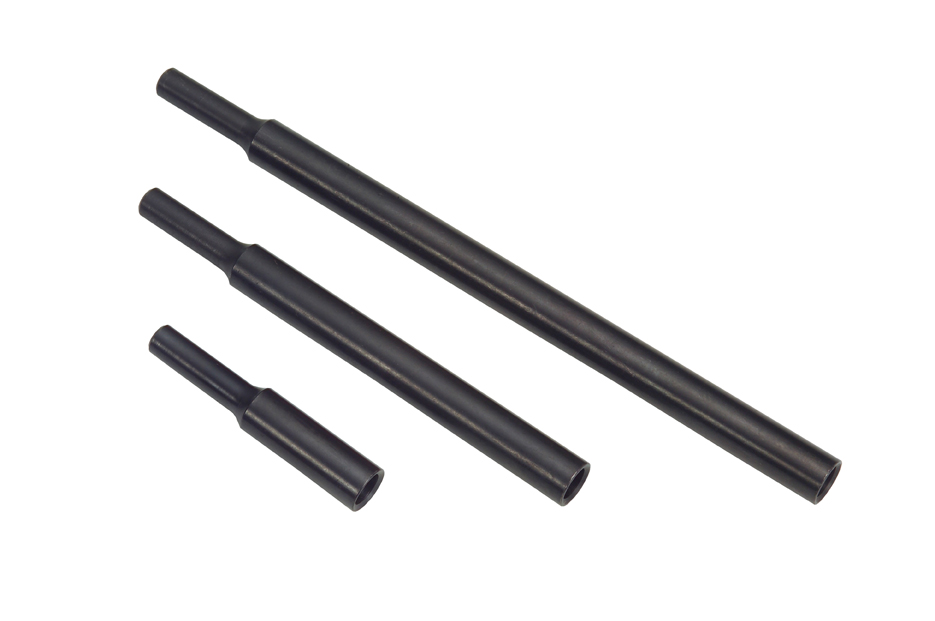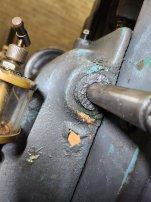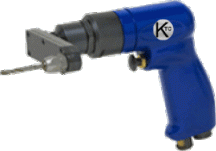Id like to have a hand drill that will take 1/16” or less twist drills that can drill parallel to interference 3/16” from drill chuck axis. My Dremel flex shaft handpiece is too large in diameter. Here’s an example of a job where I could use this. The rapid elevation handwheel mounting, cast iron, of an Abrasive 3b surface grinder was broken off by a newbie with a hammer. I know I could take a day and disassemble the top of this machine to get better access but it’d sure be nice to have a drill that’d make three reinforcing pin holes parallel to the steel shaft shown. A typical dental handpiece probably has small enough throat/clearance to do it but they all seem to need a separate power box and work at way too high rpm and too low torque. Anything available reasonably, like under $100?
How to install the app on iOS
Follow along with the video below to see how to install our site as a web app on your home screen.
Note: This feature may not be available in some browsers.
You are using an out of date browser. It may not display this or other websites correctly.
You should upgrade or use an alternative browser.
You should upgrade or use an alternative browser.
Any hand drill work as close as dental handpiece?
- Thread starter Cannonmn
- Start date
- Replies 23
- Views 1,738
IceCzar
Aluminum
- Joined
- Jul 3, 2022
Used to use the production manager's pencil die grinder alot.
but it's 1/8th and over $100
wasn't spinning the tungsten anywhere near the top end but never tried drilling with it

 webcat.cornwelltools.com
webcat.cornwelltools.com
but it's 1/8th and over $100
wasn't spinning the tungsten anywhere near the top end but never tried drilling with it

CATPDGS - Pencil Die Grinder Set
Lightweight pencil die grinder is great for limited access work. Features an 1/8” collet and stone set for added versatility. Ideal for cleaning of rotors, backing plates, brake pads, plus many other applications. Comes with a 5 foot rear exhaust over hose and built-in twist type regulator. MUST...
 webcat.cornwelltools.com
webcat.cornwelltools.com
Conrad Hoffman
Diamond
- Joined
- May 10, 2009
- Location
- Canandaigua, NY, USA
It's very hard for a small diameter device to develop high torque. I'm not aware of any specific small handpiece with a planetary gearbox, but that would fill the bill. If you do a search, they do exist, but tend to be expensive and/or obscure.
Thx for info, I can see the chances of getting a tool,as I’ve described are very slim, no pun intended. So my other possible time saving approach was to simply clean up the fracture
and use Devcon 1500 psi epoxy. I did some calculations, fracture annular surface area is 1.33 sq. Inch, so theoretical tensile strength of joint is nearly 2000,lbs. Derate the Hell out of that textbook figure and you still have more hold power than I think the geared-handcrank shaft bushing would see in normal use. The steel shaft keeps it from getting much bending stress. I mentioned this to our local machinist club and was basically condemned, no one thought it would work, or perhaps some didn’t want to buck the majority, dunno. Has anyone had good results using un-reinforced epoxy to fix low-stress cast iron? I thought the very rough fracture surface would be an advantage, might prevent a beginning separation from propagating.
and use Devcon 1500 psi epoxy. I did some calculations, fracture annular surface area is 1.33 sq. Inch, so theoretical tensile strength of joint is nearly 2000,lbs. Derate the Hell out of that textbook figure and you still have more hold power than I think the geared-handcrank shaft bushing would see in normal use. The steel shaft keeps it from getting much bending stress. I mentioned this to our local machinist club and was basically condemned, no one thought it would work, or perhaps some didn’t want to buck the majority, dunno. Has anyone had good results using un-reinforced epoxy to fix low-stress cast iron? I thought the very rough fracture surface would be an advantage, might prevent a beginning separation from propagating.
L Vanice
Diamond
- Joined
- Feb 8, 2006
- Location
- Fort Wayne, IN
In dental equipment, there is a thing called a latch type contra angle handpiece that is as slim as you are wanting. The catch is that the most common type only holds RA type burs, which have shanks that are 3/32" diameter. It would be dead easy to modify a 3/32" drill bit by cutting a groove in the shank and milling or filing a little flat on the end. The groove is the thrust mechanism and the flat is the driving mechanism, so they can transmit a fair amount of torque. In fact, I broke a gear tooth in the first Foredom contra angle handpiece I bought, alerting me to the weakest link in that chain. But I was trying to cut steel with a larger than normal size RA bur. The gears are fine with normal size burs doing normal dental chores. You can get a complete Chinese electronic control and handpiece set from eBay sellers for less than $100.
There is a less common contra angle handpiece that takes FG style burs that have plain 1/16" shanks. You would think a 1/16" drill bit would work in them. The catch is that FG stands for friction grip and I suspect they are low torque, though I never owned one. Most dentists use tiny diamond grit FG burs at very high speed, so low torque.
Larry
There is a less common contra angle handpiece that takes FG style burs that have plain 1/16" shanks. You would think a 1/16" drill bit would work in them. The catch is that FG stands for friction grip and I suspect they are low torque, though I never owned one. Most dentists use tiny diamond grit FG burs at very high speed, so low torque.
Larry
Last edited:
50BMG DUDE
Cast Iron
- Joined
- Jun 17, 2013
- Location
- Bonners Ferry
Why not make an extended drill with a 12" or so peice of 1/4" drill rod. Drill a hole in the end with your drill bit you need to use. flip it around and either braze it in or use a setscrew. Should get you enough length to run it in a regular cordless drill.
IceCzar
Aluminum
- Joined
- Jul 3, 2022
there are also Foredom flexible shaft driven handpieces
I've one 20 years old from before they offered the pencil line
I've one 20 years old from before they offered the pencil line
implmex
Diamond
- Joined
- Jun 23, 2002
- Location
- Vancouver BC Canada
Hi Cannonman:
I'm with 50BMG DUDE in post #6.
I'd also make a collar to fit over the shaft with your hole pattern in it to act as a drill guide.
I say this because a dental handpiece, even the very best of them, cannot handle the axial thrust needed to drill steel or CI for any length of time.
I used to do dental implant disaster recovery as part of my practice, and that involves drilling out broken titanium alloy screws with low speed and high torque.
I still have about half a dozen ruined contra angle latch handpieces that just couldn't take the axial thrust.
These were very expensive W&H handpieces, built like a tank, and costing almost 2 grand a pop (I made a lot of money doing that particular dental subspecialty so I could live with the extravagant cost of replacing handpieces all the time), but drilling any amount of steel...yeah you can do it but...
50BMG DUDE's solution is the obvious one and it has the great virtue of being cheap too.
Cheers
Marcus
www.implant-mechanix.com
www.vancouverwireedm.com
I'm with 50BMG DUDE in post #6.
I'd also make a collar to fit over the shaft with your hole pattern in it to act as a drill guide.
I say this because a dental handpiece, even the very best of them, cannot handle the axial thrust needed to drill steel or CI for any length of time.
I used to do dental implant disaster recovery as part of my practice, and that involves drilling out broken titanium alloy screws with low speed and high torque.
I still have about half a dozen ruined contra angle latch handpieces that just couldn't take the axial thrust.
These were very expensive W&H handpieces, built like a tank, and costing almost 2 grand a pop (I made a lot of money doing that particular dental subspecialty so I could live with the extravagant cost of replacing handpieces all the time), but drilling any amount of steel...yeah you can do it but...
50BMG DUDE's solution is the obvious one and it has the great virtue of being cheap too.
Cheers
Marcus
www.implant-mechanix.com
www.vancouverwireedm.com
Thx, sounds practical. I’d probably make a wide drill bushing with one hole for drill and larger one to fit the steel shaftWhy not make an extended drill with a 12" or so peice of 1/4" drill rod. Drill a hole in the end with your drill bit you need to use. flip it around and either braze it in or use a setscrew. Should get you enough length to run it in a regular cordless drill.
implmex
Diamond
- Joined
- Jun 23, 2002
- Location
- Vancouver BC Canada
Hi again Cannonmn:
My only comment with regard to an epoxy repair of this kind is that you will likely not be able to rely on it as a structural or functional repair.
So why do it at all?
If the function is cosmetic only, you can perhaps justify it, but anything other than that, you are dreaming IMO.
So I am not a fan.
Cheers
Marcus
www.implant-mechanix.com
www.vancouverwireedm.com
My only comment with regard to an epoxy repair of this kind is that you will likely not be able to rely on it as a structural or functional repair.
So why do it at all?
If the function is cosmetic only, you can perhaps justify it, but anything other than that, you are dreaming IMO.
So I am not a fan.
Cheers
Marcus
www.implant-mechanix.com
www.vancouverwireedm.com
Bill D
Diamond
- Joined
- Apr 1, 2004
- Location
- Modesto, CA USA
Would an aircraft pancake drill work or is the head too large? The drills are 1/4-28 thread attachment. They also make pork chop drill adapters you use with your existing drill motor.
Jiffy and aro are makers names
Bill D
Jiffy and aro are makers names
Bill D
Attachments
Ron Hofer
Hot Rolled
- Joined
- Jul 7, 2007
- Location
- Brookfield, WI
As far as handpiece go, look into dental lab grinders. Air powered, a slightly thicker barrel and a great deal more torque than a standard dental handpiece. I've run 4-5 dental and 1-2 lab pieces for three decades. The lab handpieces are Clydesdales compared to dental Shetland Ponies.
Ron Hofer
Hot Rolled
- Joined
- Jul 7, 2007
- Location
- Brookfield, WI
I look forward to Marcus weighing in.As far as handpiece go, look into dental lab grinders. Air powered, a slightly thicker barrel and a great deal more torque than a standard dental handpiece. I've run 4-5 dental and 1-2 lab pieces for three decades. The lab handpieces are Clydesdales compared to dental Shetland Ponies.
implmex
Diamond
- Joined
- Jun 23, 2002
- Location
- Vancouver BC Canada
Hi Ron:
Sadly I'm unfamiliar with the dental lab grinders you're referring to.
Way back when, when I was still in the business, dental labs in my area mostly used handpieces very similar to those used by dentists except the motors were electric instead of air motors.
In fact, the handpieces themselves were usually dental NSK straight handpieces using 2.35mm diameter shanked burs and abrasive wheels, exactly the same as are used for trimming dentures by dentists.
Nobody in the lab world near me used contra angle handpieces back then...they were all straight handpieces, so no use for what the OP wants to do.
It's the witzy little bevel gears and the absence of decent thrust bearings in a contra angle handpiece that makes them so vulnerable to heavy thrust loads.
Most just have bronze bushings and the bearing surfaces are tiny, so they just get eaten when you push them.
The other kinds of lab grinders were all bench machines, and of those there were two main kinds.
One was specialized for polishing removable partial dentures, the other was a general purpose machine, and a common brand was Redwing.
I have no idea what's being used now.
Cheers
Marcus
www.implant-mechanix.com
www.vancouverwireedm.com
Sadly I'm unfamiliar with the dental lab grinders you're referring to.
Way back when, when I was still in the business, dental labs in my area mostly used handpieces very similar to those used by dentists except the motors were electric instead of air motors.
In fact, the handpieces themselves were usually dental NSK straight handpieces using 2.35mm diameter shanked burs and abrasive wheels, exactly the same as are used for trimming dentures by dentists.
Nobody in the lab world near me used contra angle handpieces back then...they were all straight handpieces, so no use for what the OP wants to do.
It's the witzy little bevel gears and the absence of decent thrust bearings in a contra angle handpiece that makes them so vulnerable to heavy thrust loads.
Most just have bronze bushings and the bearing surfaces are tiny, so they just get eaten when you push them.
The other kinds of lab grinders were all bench machines, and of those there were two main kinds.
One was specialized for polishing removable partial dentures, the other was a general purpose machine, and a common brand was Redwing.
I have no idea what's being used now.
Cheers
Marcus
www.implant-mechanix.com
www.vancouverwireedm.com
PeteM
Diamond
- Joined
- Jan 15, 2002
- Location
- West Coast, USA
1/4" hex bit extensions are cheap, as are drill bits with hex bit ends. Commonly available in up to 12" lengths and happy to be stacked further away or welded on to a rod of your choosing.
The slim magnetic hex bit holders are around 3/8" max diameter - meaning you can get within 3/16". The firm locking ones won't get quite as close, but will make you happier when trying to back out the drill bit.
Want to get closer to a shoulder? Easy enough to weld a drill bit on to the end of a rod - which sounds like your plan.
Drill bits are also available in 12" and 18" lengths. The smaller ones are flexible enough to be run through a drill guide near the desired hole and chucked off at a clearance angle further back.
The slim magnetic hex bit holders are around 3/8" max diameter - meaning you can get within 3/16". The firm locking ones won't get quite as close, but will make you happier when trying to back out the drill bit.
Want to get closer to a shoulder? Easy enough to weld a drill bit on to the end of a rod - which sounds like your plan.
Drill bits are also available in 12" and 18" lengths. The smaller ones are flexible enough to be run through a drill guide near the desired hole and chucked off at a clearance angle further back.
Last edited:
Bill D
Diamond
- Joined
- Apr 1, 2004
- Location
- Modesto, CA USA
You can buy or make 1/4-28 extensions to use threaded aircraft drills. No need for straight shank drills and a collet or chuck.
BilL D

 www.aircraftspruce.com
www.aircraftspruce.com
BilL D

Drill Extension - Straight Shank To Female 1/4-28 Thread | Aircraft Spruce
Drill Extension - Straight Shank To Female 1/4-28 Thread Use these different length extensions in your 90°or 45° drills. VV
ratbldr427
Titanium
- Joined
- Mar 21, 2006
- Location
- jacksonville,fl.
The drill bit extention is the easiest quickest and cheapest, have had to do that a few times. I have one of those aircraft ra drills like Bill D posted. I used it last week to ream a 5mm taper pin hole in an awkward position. Had to braze the reamer to a threaded adaptor. It is pretty powerful for its size.
1/4-28 90 degree aircraft drill?
https://www.ebay.com/itm/2254270392...39&osub=-1~1&crd=20230217144512&segname=11050
https://www.ebay.com/itm/2254270392...39&osub=-1~1&crd=20230217144512&segname=11050
Similar threads
- Replies
- 46
- Views
- 6K
- Replies
- 26
- Views
- 4K
- Replies
- 42
- Views
- 8K
- Replies
- 57
- Views
- 18K





